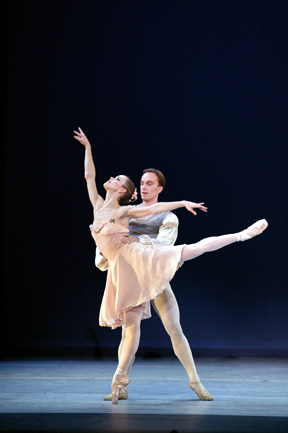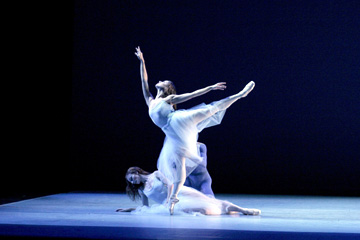Dancing that Breathes
Suzanne
Farrell Ballet
Presented by Cal Performances
Zellerbach Hall
November 14, 2003
By Rita Felciano
copyright © 2003 by Rita Felciano
 Not
having lived through the Golden Age of New York City Ballet, the moans
and groans about paradise lost have always evoked more sympathy than understanding.
Maybe we do live in an Iron Age, but if you have only seen Violette and
Maria and Patty and Melissa and Merrill dance on tape on a very small
screen, it’s difficult to assess what exactly you have missed. But
now the Golden Girl of the New York City Ballet, Suzanne Farrell, has
opened the door for a glimpse into what may have been, after all, a garden
of earthly delights.
Not
having lived through the Golden Age of New York City Ballet, the moans
and groans about paradise lost have always evoked more sympathy than understanding.
Maybe we do live in an Iron Age, but if you have only seen Violette and
Maria and Patty and Melissa and Merrill dance on tape on a very small
screen, it’s difficult to assess what exactly you have missed. But
now the Golden Girl of the New York City Ballet, Suzanne Farrell, has
opened the door for a glimpse into what may have been, after all, a garden
of earthly delights.
Despite some technical insecurities—a balance missed here, a flubbed entry there— and repertoire that could have been more rewarding, the Suzanne Farrell Ballet company presented extraordinary evidence of what can be done with vision, discipline and support. Considering the fact, that the ensemble is but a bare four years old, works together for part of the year only, and employs dancers from all over, the company’s cohesion, the quality of their dancing and their understanding of style is all the more remarkable. Farrell was a great dancer, she just might become a great artistic director. The first American woman to do so.
Maybe the most extraordinary pleasure was watching the dancers’ bodily integration. The impetus generated by the fine leg work—strong but never forced-- naturally rose through the torso and lyrically flowed out into the port de bras. The point work was delectably nuanced, with luxurious ascents or like an impatient bud popping up through the earth. Even tiny beats, or something as simple as retirés, were clearly etched. The softest of descents—even the men’s--made you believe that the dancers landed on sponges or clouds instead of wood. Even if not all the dancers succeeded all the time, it was clear that Farrell has imprinted them with her ideas on classical dancing. It’s dance that breathes, that is volatile, that takes risks. These artists moved as a unit, not machine-like, but like one body, or maybe some sort of idealized community.
 Now
for the repertoire. The company travels with four different programs.
In the East Bay they performed Divertimento No. 15, Tempo di Valse,
Tchaikovsky Pas de Deux and Serenade. Berkeley missed out
on the best of the four—Divertimento No.15, Variations for Orchestra,
Tzigane and Apollo. That one was scheduled for the Flint
Center for the Performing Arts, down the Peninsula in Santa Clara County
and was cancelled because ten days before the performance only 100 tickets
had been sold. So much for the Bay Area’s much vaunted cultural
sophistication.
Now
for the repertoire. The company travels with four different programs.
In the East Bay they performed Divertimento No. 15, Tempo di Valse,
Tchaikovsky Pas de Deux and Serenade. Berkeley missed out
on the best of the four—Divertimento No.15, Variations for Orchestra,
Tzigane and Apollo. That one was scheduled for the Flint
Center for the Performing Arts, down the Peninsula in Santa Clara County
and was cancelled because ten days before the performance only 100 tickets
had been sold. So much for the Bay Area’s much vaunted cultural
sophistication.
The program opened with Divertimento No. 15, which turned out to be the evening’s highlight. An oddly constructed, but in the hands of a master perfectly natural master piece, Farrell’s dancers performed it with a sense of both demure decorum and rapturous abandon. That’s an unbeatable combination and fit the music to a t.
Divertimento is a piece in which surprise and invention simply tumble over each other. The opening pose, for instance, shows the women in lilac tutus, looking like an architectural ornament—perhaps a rosette in one of those stucco-encrusted baroque palaces. And then the “camera” suddenly switches direction and brings into frame two male dancers (Momchil Mladenov and Alexander Ritter), who set the scene for the variations, These brought their own surprises, rolling one on top of each other like bubbles escaping from a bottle. Though they had in common feathery and lightening fast footwork imbued with quicksilvery spirit, each one had its own stamp. There were delicious balancés in one, filigreed hops in another and almost-robust developpés in yet a third. And just when you think that this will be an all female affair, in pops yet another male—Runqiao Du who apparently couldn’t miss a jump’s landing if he tried. April Ball’s pawing brush steps and quasi struts filled the fourth variation with a wonderful sense of freedom; Shannon Parsley tore through her fiendish footwork and turns with a sense of almost reckless abandonment.
In the Minuet’s handholding skipping steps, the octet was so perfectly coordinated yet so lively that the dancers looked like nothing so much as a chain of delicate tissue paper cut outs.
 Maybe
the Andante was my favorite section. Its easy formality, the elegance
of its promenades and manèges, the naturalness of the way three
men partnered five women and that wonderful suggestion of something like
a kick line that ends in arabesque penchés is simple genius. And
such a joyously formal ending. Men and women gathered in separate circles,
raised their arm in a moment of intense privacy, then opened into public
acknowledgment of each other with formal bows and withdrawals into the
wings. I can’t help but think that Mozart would have loved it.
Maybe
the Andante was my favorite section. Its easy formality, the elegance
of its promenades and manèges, the naturalness of the way three
men partnered five women and that wonderful suggestion of something like
a kick line that ends in arabesque penchés is simple genius. And
such a joyously formal ending. Men and women gathered in separate circles,
raised their arm in a moment of intense privacy, then opened into public
acknowledgment of each other with formal bows and withdrawals into the
wings. I can’t help but think that Mozart would have loved it.
It’s understandable that Farrell programmed Tempo di Valse from The Nutcracker. She has a beautifully trained, refined group of women whom she wants to highlight. Also Balanchine’s choreography, with its liquid transformation of lines and group patterns that blow by as if driven by the wind--read the music--that reshapes clouds, is first rate. The rushing across the stage, the bunching up on one side, the opening of the lines to frame Bonnie Pickard was quite wonderful to watch.
However, the soft pink skirts, highlighted against a rose colored proscenium were just ghastly. There was enough sugar to cause a serious case of diabetes. And to listen to that shopworn scorn, isolated from the rest of the ballet and played on tape, was testing at least this viewer’s patience.
The bravura aspect of Tchaikovsky Pas de Deux with that gasp-inducing leap across space, as performed by Peter Boal and Jennifer Fournier, had a lovely, light-handed and fleet-footed quality to it which elevates it above other show pieces. But it’s not one of Balanchine’s most inventive works.
Serenade also was a safe choice. But, as a friend pointed out, it’s always good to see a great piece again, and many members of the audience for this tour may not ever have seen this “first” American ballet. Looking at these svelte ballerinas whose legs seemed longer than ever emerging from and receding into those gauzy pale blue skirts, it was difficult to visualize what the first rather stocky dancers, clad as they were in shorts and bottom-covering skirts, must have looked like. But clearly the choreography with its wonderfully suggestive and yet so elusive images came across already in 1934.
If Balanchine created this piece in order to teach his fledgling group ensemble work, Farrell’s troupe showed that they do it well. A common impulse, a common understanding of how to go from à terre through the arch onto point, of how to rise in one breath from a bent to a straightened torso, buoyed this Serenade. These dancers sang from the first lowered arm across the chest that modestly pulled down the gaze to that last heavenwards glance high on point in the apotheosis, or funeral, or whatever that procession leads towards.
 Serenade
is a ballet of images, few more incisive than the circle dance which ends
in the kneeling position with the dancers arms wafting as if anticipating
the beating of the Angel’s wings. Another dramatic one comes in
the quintet in which the dancers sink to the ground as if a split was
the most natural position to be in. And then to top it, they exchanged
looks before gracefully extending a hand to a partner. It is such a lovely
interlude situated as it is between the waltz—Chan Hon Goh delicatedly
partnered by Mladenov—and the Elegy.
Serenade
is a ballet of images, few more incisive than the circle dance which ends
in the kneeling position with the dancers arms wafting as if anticipating
the beating of the Angel’s wings. Another dramatic one comes in
the quintet in which the dancers sink to the ground as if a split was
the most natural position to be in. And then to top it, they exchanged
looks before gracefully extending a hand to a partner. It is such a lovely
interlude situated as it is between the waltz—Chan Hon Goh delicatedly
partnered by Mladenov—and the Elegy.
I am not sure how Goh got there but she looked positively shattered, prone on that floor, as though she had fallen from a great height. Stately, measured and as mysterious as ever, Ritter and Natalia Magnicaballi as the Dark Angel couple magnified Goh’s vulnerabiliy. Their trio was full of wonder and trust.
In the end, the only unsatisfying aspect of Serenade was what was wrong with the whole program: canned music. Dancers as musically trained as these by one of the most musical dancers of the twentieth century deserve live music. They need it for their own growth. And so do we.
Photos:
Company members of the Suzanne Farrell Ballet perform the “Tempo di Valse” section of the Nutcracker
Jennifer Fournier and Peter Boal of the Suzanne Farrell Ballet perform George Balanchine’s Tchaikovsky Pas de Deux
Company members of the Suzanne Farrell Ballet perform George Balanchine's Serenade
April Ball (pointe) and Bonnie Pickard (on floor) of the Suzanne Farrell Ballet perform George Balanchine's Serenade
photos: Jon Nalon
Originally
published:
www.danceviewtimes.com
Volume 1, Number 8
November 17, 2003
Copyright ©2003 by Rita Felciano
|
|
|